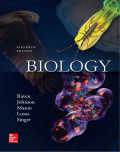
Concept explainers
Source-sink metapopulations are distinct from other types of metapopulations because
a. exchange of individuals only occurs in the former.
b.
c. populations never go extinct in the former.
d. all populations eventually go extinct in the former.
Introduction:
When the network of different populations exchanges its individuals, it is known as metapopulation. This happens because of the distribution of suitable and unsuitable habitat. If there is difference in the habitats of long term populations which affect its growth and decline is known as source-sink metapopulation.
Answer to Problem 1U
Correct answer:
The decline in the population is also considered in the source-sink metapopulation. Therefore, option b. is correct.
Explanation of Solution
Reason for the correct statement:
In source-sink population, there is continuous sending of dispersers from better areas that bolster the population in the areas that are poorer. The better areas or habitats act as the source and the poorer areas or habitats act as sink. If there is no continuous shifting of individuals, then the sink population increases and shows a negative growth and may lead to extinction.
Option b. is given as“populations with negative growth rates are a part of the former”.
As, “Source-sink metapopulations are distinct from the types of metapopulations because populations with negative growth rates are a part of the former”, is the right answer.
Hence, the option b. is correct.
Reasons for the incorrect statements:
Option a. is given as “exchange of individuals only occurs in the former”.
The exchange of individuals occurs in both metapopulations as well as in the source-sink populations. So, it is a wrong answer.
Option c. is given as “populations never go extinct in the former”.
In sink-source metapopulations, if the continuous replenishment is absent, then the poor habitat show negative growth rates that may lead to the extinction of species. So, it is a wrong answer.
Option d. is given as “all populations eventually go extinct in the former”.
Not all the populations show negative growth; only a part of population of poorer habitat show negative growth and extinct. So, it is a wrong answer.
Hence, options a., c., and d. are incorrect.
The metapopulations involves the migration of individuals from one group to another group in a population. In source-sink population, one of the populations with poor habitat may show negative growth.
Want to see more full solutions like this?
Chapter 55 Solutions
EBK BIOLOGY
- Describe the levels of structural hierarchy for the human body, starting with the organismal level and ending with the chemical level. In addition, you should make sure you link each level to the previous level, emphasizing the structural relationships.arrow_forward9 S es Read the section "Investigating Life: In (Extremely) Cold Blood." Then, drag and drop the terms on the left to complete the concept map. Red blood cells Genes Icefishes -have mutated have colorless Oxygen have few lack encode Blood Cellular respiration consists of- contain carries is a Platelets White blood cells carries low amounts of Hemoglobin is necessary for Plasma Protein Reset.arrow_forwardPlating 50 microliters of a sample diluted by a factor of 10-6 produced 91 colonies. What was the originalcell density (CFU/ml) in the sample?arrow_forward
- Every tutor here has got this wrong, don't copy off them.arrow_forwardSuppose that the population from question #1 (data is in table below) is experiencing inbreeding depression (F=.25) (and no longer experiencing natural selection). Calculate the new expected genotype frequencies (f) in this population after one round of inbreeding. Please round to 3 decimal places. Genotype Adh Adh Number of Flies 595 Adh Adh 310 Adhs Adhs 95 Total 1000 fladh Adh- flAdn Adh fAdhs Adharrow_forwardWhich of the following best describes why it is difficult to develop antiviral drugs? Explain why. A. antiviral drugs are very difficult to develop andhave no side effects B. viruses are difficult to target because they usethe host cell’s enzymes and ribosomes tometabolize and replicate C. viruses are too small to be targeted by drugs D. viral infections usually clear up on their ownwith no problemsarrow_forward
- This question has 3 parts (A, B, & C), and is under the subject of Nutrition. Thank you!arrow_forwardThey got this question wrong the 2 previous times I uploaded it here, please make sure it's correvct this time.arrow_forwardThis question has multiple parts (A, B & C), and under the subject of Nutrition. Thank you!arrow_forward
- Calculate the CFU/ml of a urine sample if 138 E. coli colonies were counted on a Nutrient Agar Plate when0.5 mls were plated on the NA plate from a 10-9 dilution tube. You must highlight and express your answerin scientific notatioarrow_forwardDon't copy off the other answer if there is anyarrow_forwardAnswerarrow_forward
 Biology (MindTap Course List)BiologyISBN:9781337392938Author:Eldra Solomon, Charles Martin, Diana W. Martin, Linda R. BergPublisher:Cengage Learning
Biology (MindTap Course List)BiologyISBN:9781337392938Author:Eldra Solomon, Charles Martin, Diana W. Martin, Linda R. BergPublisher:Cengage Learning Concepts of BiologyBiologyISBN:9781938168116Author:Samantha Fowler, Rebecca Roush, James WisePublisher:OpenStax College
Concepts of BiologyBiologyISBN:9781938168116Author:Samantha Fowler, Rebecca Roush, James WisePublisher:OpenStax College
 Human Biology (MindTap Course List)BiologyISBN:9781305112100Author:Cecie Starr, Beverly McMillanPublisher:Cengage Learning
Human Biology (MindTap Course List)BiologyISBN:9781305112100Author:Cecie Starr, Beverly McMillanPublisher:Cengage Learning Biology: The Dynamic Science (MindTap Course List)BiologyISBN:9781305389892Author:Peter J. Russell, Paul E. Hertz, Beverly McMillanPublisher:Cengage Learning
Biology: The Dynamic Science (MindTap Course List)BiologyISBN:9781305389892Author:Peter J. Russell, Paul E. Hertz, Beverly McMillanPublisher:Cengage Learning





